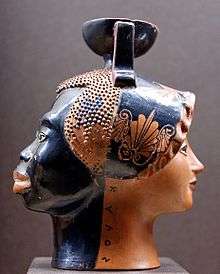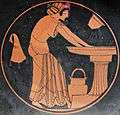Kalos inscription
A kalos inscription is a form of epigraph found on Attic vases and graffiti in antiquity, mainly during the Classical period from 550 to 450 BC. The word kalos (καλός) means "beautiful", and in the inscriptions it had an erotic connotation.[2]
Overview
The kalos inscription is typically found on vessels used for a symposium. The scenes that accompany the inscription vary, and include athletic exercises and myths.
Some inscriptions are generic, reading only "the boy is beautiful" (ὅ παῖς καλός).[3] The inscription more often took the form of the beloved's name, in the nominative singular, followed by "kalos" (X kalos, i.e. "X is beautiful"). The beloved is most often a male youth, but sometimes girls or women were spoken of as kalē (καλή). In one early cataloging of the inscriptions, among the individuals labeled as beautiful were 30 women and girls, and 528 youths.[4] Male names outnumber female by more than twenty to one. At least some of the women labeled kalē were hetairai, courtesans or prostitutes.[5]

The names designated as kalos are characteristic of aristocratic citizens.[6] Some kalos inscriptions are associated with certain vase painters or pottery workshops. The Antimenes Painter, for instance, is named for the kalos inscription to Antimenes on his pots, and the Leagros Group pottery workshop is named for the youth Leagros, a widely popular object of kalos praise.[7] These associations suggest a cult of celebrity or a concerted effort by a given youth's family to increase their son's public standing.
The purpose of these inscriptions remains uncertain, and many examples may be declarations of love as part of same-sex courtship in Athens.[8] In some cases, the inscriptions or vessels may have been made to order.
Kalos names are also found as graffiti on walls, the most abundant example being the find on Thassos of 60 kalos inscriptions carved on rock dating from the 4th century. The non-epigraphic literary evidence consists of two references in Aristophanes.[9] Both of these instances, however, praise the demos (the citizenry as a whole) rather than any individual, and suggest the public performance role of the kalos tag.
Examples


 Minotaur with generic "the boy is beautiful" inscription (ca. 515 BC)
Minotaur with generic "the boy is beautiful" inscription (ca. 515 BC) Kalē woman bathing (ca. 500 BC)
Kalē woman bathing (ca. 500 BC) A sexual solicitation (5th century BC), with generic inscription
A sexual solicitation (5th century BC), with generic inscription Nike offering a wreath to an athletic victor (460–450 BC)
Nike offering a wreath to an athletic victor (460–450 BC) Double inscription
Double inscription
References
- ↑ Inscription on the left: (Ϝ(?))ENEMEKNERINE (???), HERMOΓΕΝΕS KALOS ("Hermogenes kalos"). Inscription on the up-right: HEOS ("Eos"), ΔΟRIS EΓRAΦSEN ("Doris Egraphsen"—Doris drew me). Insription on the right: MEMNON ("Memnon"), KALIAΔES EΠOIESEN ("Kaliades epoiesen"—Kaliades made me).
- ↑ Andrew J. Clark, Maya Elston, and Mary Louise Hart, Understanding Greek Vases: A Guide to Terms, Styles, and Techniques (Getty Museum, 2002), p. 100.
- ↑ Clark, Elston, and Hart, Understanding Greek Vases, p. 100.
- ↑ Wilhelm Kroll, "Knabenliebe" in Pauly-Wissowa, Realencyclopaedie der klassischen Altertumswissenschaft, vol. 11, cols. 897–906.
- ↑ Clark, Elston, and Hart, Understanding Greek Vases, p. 100.
- ↑ Clark, Elston, and Hart, Understanding Greek Vases, p. 100.
- ↑ Clark, Elston, and Hart, Understanding Greek Vases, p. 100.
- ↑ Clark, Elston, and Hart, Understanding Greek Vases, p. 100.
- ↑ Aristophanes, The Acharnians, line 144; The Wasps, lines 97-99.
- ↑ Clark, Elston, and Hart, Understanding Greek Vases, p. 7.
Sources
- Neil W. Slater. "The Vase as Ventriloquist: Kalos-inscriptions and the Culture of Fame", in Signs of Orality: The Oral Tradition and its Influence in the Greek and Roman World (ed. E. Anne Mackay). Leiden: Brill, 1999, pp. 143–161.
- Kenneth J. Dover. Greek Homosexuality. 2nd edition. London: Duckworth, 1989.
- François Lissarrague. Publicity and performance. Kalos inscriptions in Attic vase-painting, In: Performance Culture and Athenian Democracy, Cambridge 1999, pp. 359–373.
- H. Alan Shapiro. Leagros the Satyr in Greek Vases: Images, Contexts and Controversies., ed. Clemente Marconi, 2004, pp. 1–12.
External links
| Wikimedia Commons has media related to Kalos inscriptions. |
